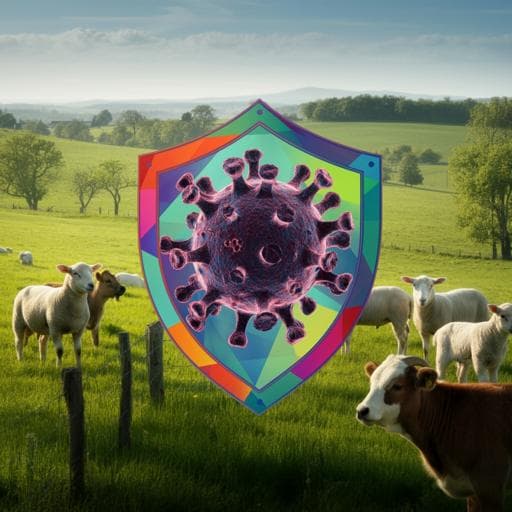
Veterinary Science
Safety and efficacy of four-segmented Rift Valley fever virus in young sheep, goats and cattle
P. J. W. Schreur, N. Oreshkova, et al.
Discover groundbreaking research on Rift Valley fever virus (RVFV), where the developed RVFV-4s vaccine candidate is shown to be completely avirulent and induces protective immunity in various animals. This essential study was conducted by leading experts including Paul J. Wichgers Schreur and Nadia Oreshkova.
~3 min • Beginner • English
Introduction
Rift Valley fever virus (RVFV) is a phlebovirus causing abortions in pregnant ruminants, high mortality in newborns, and febrile to severe disease in humans. With more than 50 mosquito species implicated and potential for spread beyond current endemic regions, effective and safe vaccines for livestock are urgently needed to curb outbreaks and zoonotic risk. Existing inactivated vaccines require multiple doses, while live-attenuated vaccines (e.g., Smithburn, Clone 13) can protect after a single dose but have safety concerns, particularly in very young or pregnant animals, including residual virulence and potential for vertical transmission at high doses. Using reverse genetics, the authors previously engineered a four-segmented RVFV (RVFV-4s) by splitting the M segment to separately encode Gn and Gc and deleting NSs, yielding strong attenuation with protective efficacy in lambs. The present study aims to rigorously evaluate the veterinary RVFV-4s candidate (vRVFV-4s) for safety—dissemination, shedding, spread, and reversion to virulence—and for efficacy after a single vaccination in lambs, goat kids, and calves, including protection against a heterologous RVFV strain.
Literature Review
- Control of RVF relies on vaccination; inactivated vaccines are safe across life stages but require multiple administrations; live-attenuated vaccines confer protection after a single dose but have safety trade-offs.
- Smithburn strain is effective but retains residual virulence, precluding use in very young and pregnant animals.
- Clone 13, lacking most of NSs, is generally safe and effective in lambs, cattle and pregnant ewes, but high-dose administration per European Pharmacopoeia led to vertical transmission and teratogenic effects.
- Reverse genetics enables rational attenuation strategies; RVFV genome comprises L, M, and S segments; M encodes Gn/Gc, NSm, and 78-kDa protein; various recombinant attenuated candidates show promise.
- The authors’ prior work split the M segment to generate a four-segmented RVFV (RVFV-4s) lacking NSs, showing complete safety in young lambs and pregnant ewes and protective immunity after a single immunization in lambs.
- Multi-lineage phylogenetics shows low overall diversity and a single serotype, suggesting cross-lineage neutralization is feasible.
Methodology
Ethics and housing: All animal procedures complied with EU Directive 2010/63/EU and Dutch law, approved by relevant authorities and ethics committees (Permits AVD401002017816, AVD4010020187168). Animals (sheep, goats, calves) were sourced from Dutch farms, clinically healthy, randomized to groups, housed in BSL-3, acclimatized 7 days, and monitored daily (rectal temperatures recorded daily; humane endpoints predefined).
Viruses and cells: The vaccine (vRVFV-4s) is based on RVFV strain 35/74. A master seed virus was amplified in BSR-T7 cells. Identity was confirmed by RT-PCR and next-generation sequencing. Homologous challenge used recombinant RVFV 35/74; heterologous challenge used wild-type ZH501. Virus propagation used BHK-21 (rRVFV 35/74), Vero E6 (ZH501). VNTs used RVFV-4sGFP on BHK-21 cells.
Safety study: Dissemination, shedding, spread (DSS): Nine ~4-week-old lambs were vaccinated intramuscularly (IM, biceps femoris) with 10^7 TCID50 vRVFV-4s in 1 ml and co-housed with seven unvaccinated sentinels. Samples collected: daily plasma for viremia; oral and rectal swabs and urine for shedding; terminal tissues (liver, spleen, lymph nodes, testes) for dissemination. Sentinels were sampled similarly to assess spread. Serology (VNT and anti-N ELISA) assessed immunogenicity.
Safety study: Reversion to virulence (RTV) by animal passage: Group 1 (three ~4-week-old lambs) received 10^7 TCID50 IM and were necropsied at 3 days post vaccination (DPV). Plasma, liver, spleen, and lymph nodes were tested by RT-qPCR; highest RNA load lymph node suspensions were pooled and used as inoculum. Group 2A (three naive lambs) was inoculated IM with the pool and necropsied at 3 days post inoculation. In phase 2, a larger cohort (Group 2B) was inoculated with the same pool and monitored for 21 days with serial sampling for RT-qPCR and serology; necropsy tissues were tested at termination.
Efficacy studies (homologous challenge): Single-dose vRVFV-4s vaccination IM in lambs (8–10 weeks; two dose levels), goat kids (~9 weeks; two dose levels), and calves (2–3 weeks; one dose). All animals were challenged intravenously at 21 DPV with 10^5 TCID50 of homologous rRVFV 35/74. Controls received mock vaccination. Post-challenge monitoring included daily temperatures, serial plasma for RT-qPCR and virus isolation (VI), and terminal liver and spleen for RT-qPCR. Serology (VNT and anti-N ELISA) was performed weekly.
Efficacy study (heterologous challenge): Lambs 3–4 weeks old were vaccinated once IM with vRVFV-4s and challenged at 21 DPV with 10^5 TCID50 of heterologous RVFV ZH501. Mock-vaccinated controls were euthanized at day 4 post challenge to refine and limit suffering. Clinical monitoring, plasma RT-qPCR/VI, organ RT-qPCR, and serology paralleled the homologous trials.
Laboratory assays: RT-qPCR on plasma and 10% organ homogenates used Roche LightCycler chemistry with RVFV-specific primers/probe; virus isolation on BHK-21 with TCID50 by Spearman–Kärber; serology by VNT using RVFV-4sGFP and competitive anti-N ELISA (ID-VET). For VI, only samples >10^4 RNA copies/ml were attempted based on isolation cutoff.
Statistics: One-way ANOVA with Tukey’s multiple comparisons and unpaired t-tests (GraphPad Prism 8); significance at p ≤ 0.05.
Key Findings
- Safety: In the DSS study, vaccinated lambs showed only low-level vaccine RNA in plasma at 1–2 DPV, with all plasma negative by 3 DPV. No vaccine RNA was detected in organs (liver, spleen, lymph nodes, testes), oral/rectal swabs, or urine of vaccinated animals, and no RNA in any samples from co-housed sentinel lambs. Vaccinated lambs seroconverted (neutralizing and anti-N antibodies), while sentinels remained seronegative, indicating no spread.
- Reversion to virulence: In Group 1 (high-dose vaccinated lambs), low RNA levels were detected only in some lymph nodes at 3 DPV; no infectious virus was recovered from plasma or organs. Pooled lymph node suspensions failed to transmit infection to Group 2A (necropsied at 3 days) and to Group 2B (monitored 21 days): no clinical signs, no viremia or organ RNA, and no seroconversion in Group 2B. These data indicate absent/limited replication and negligible risk of reversion to virulence upon passage.
- Efficacy (homologous challenge): After challenge with rRVFV 35/74, all control lambs developed fever and viremia; 6/8 either died acutely or reached humane endpoints. Control goat kids and calves survived but developed viremia of lower magnitude and shorter duration; virus was isolatable from plasma for ~3 days in goat kids and calves versus up to ~6 days in lambs. Control animals frequently had detectable liver/spleen RNA at necropsy. In contrast, all vRVFV-4s–vaccinated lambs, goat kids, and calves had no fever, no detectable plasma viremia, and no detectable RNA in liver or spleen. All vaccinated animals seroconverted by 21 DPV with robust neutralizing responses; a dose response (higher and faster titres at higher dose) was evident in lambs and goat kids. Goat kids had significantly higher neutralizing titres than lambs and calves at challenge and termination.
- Efficacy (heterologous challenge): In 3–4-week-old lambs, vRVFV-4s conferred complete protection against heterologous ZH501: no fever, viremia, or organ RNA. Mock-vaccinated controls developed fever and viremia; one died at day 2 post infection with high organ RNA; others had variable organ RNA by day 4. Vaccinated lambs mounted neutralizing and anti-N antibody responses similar to older lambs, with somewhat greater inter-animal variability.
Overall, a single vRVFV-4s vaccination provided sterile protection in multiple ruminant species against homologous challenge and full protection in young lambs against a heterologous strain, with no evidence of dissemination, shedding, spread, or reversion to virulence.
Discussion
The study addresses critical safety concerns inherent to live-attenuated RVFV vaccines by using a rationally attenuated, four-segmented virus lacking NSs. High-dose safety testing in the most susceptible target species (young lambs) showed absence of significant replication, dissemination, shedding, or spread to sentinels, and failure to passage infection or induce seroconversion, supporting a negligible risk of reversion to virulence in the field. Efficacy trials demonstrated that a single IM dose of vRVFV-4s elicits robust neutralizing antibody responses and confers complete clinical and virological protection against homologous challenge in lambs, goat kids, and calves. Species differences observed—higher magnitude and longer duration of viremia in lamb controls, and higher neutralizing titres in vaccinated goat kids—are consistent with prior reports and underscore species-specific host responses and transmission potential. Protection against the heterologous ZH501 strain in very young lambs supports cross-lineage efficacy consistent with a single RVFV serotype. Collectively, vRVFV-4s appears to meet key safety and efficacy benchmarks for a next-generation veterinary RVF vaccine and could play a significant role in outbreak control and prevention in diverse ruminant hosts.
Conclusion
vRVFV-4s, a four-segmented live-attenuated RVFV vaccine candidate, demonstrated an excellent safety profile in young lambs with no dissemination, shedding, spread, or reversion to virulence, even after high-dose administration. A single vaccination conferred sterile protection against homologous challenge in lambs, goat kids, and calves, and full protection against a heterologous strain (ZH501) in very young lambs, with robust neutralizing antibody responses across species. Future work should optimize dosing regimens (particularly assessing lower doses in calves), further elucidate the roles of antibody isotypes/subclasses and affinity maturation in neutralization, and evaluate performance under field conditions and across additional RVFV lineages and age groups.
Limitations
- Vaccine dosing details in cattle suggest potential discrepancies (text notes a higher dose in calves), and optimal minimal protective doses, especially in calves, were not fully defined; authors note further dose-ranging studies are needed.
- While protection against two strains (35/74 and ZH501) was shown, broader field validation across more RVFV lineages and ecological settings was not conducted.
- Some group sizes were modest, and studies were performed under controlled BSL-3 conditions; real-world performance, vector-mediated transmission dynamics, and duration of immunity were not assessed.
- Mechanistic correlates of protection beyond neutralizing antibody titres (e.g., isotype/subclass contributions, T-cell responses) were not dissected.
Related Publications
Explore these studies to deepen your understanding of the subject.







